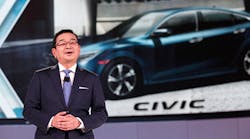Nine months into his tenure atop Honda Motor Co., CEO and president Takahiro Hachigo has plans in place to put product recalls and quality issues behind the automaker.
After taking stock of what ailed Japan’s third-largest auto manufacturer, assembling a new management team and making organizational changes, the Honda lifer sat down for an interview. Here’s what the former engineer of the CR-V sport utility vehicle and Odyssey minivan said about the changes he’ll make at Honda, its alliance with General Motors Co. and his hopes for Japan Prime Minister Shinzo Abe’s economic policies.
On lessons learned … I have traveled to our facilities in Japan, North America and Asia to listen to employees. What I learned is the communication hasn’t been sufficient. The organization has become complicated. Employees spent a lot of time on arranging and reporting, and did not have the time to think and discuss about the customers.
Since it’s not clear who’s in charge, the employees have to talk to a lot of people. This has resulted in a lot of information not reaching the right people, or what we want to do isn’t getting across. As we have established a business structure based on six regions, the speed has been too fast and that has increased the workload at the research centers and the plants to cope with the development.
On Honda’s global outlook … Over the past few years of expansion, we have built a global capacity of 5.5 million units. There’s no immediate need to build new plants. In the next three to four years, we will try to fill the gap between sales and production capacity.
While we have spare capacity, in North America we still need capacity for light truck. China capacity is almost fully used as we sold more than 1 million cars last year. In Europe, there is demand for the Civic hatchback. The problem is Japan and Thailand. We plan to increase exports from Japan in the next three to four years to raise production to 950,000 units so that we can cover fixed costs. And in Thailand, we will also raise plant utilization.
On shifting to global models … We have designed region-specific models in North America, China and Asia. We have to make global vehicles including Fit and Accord more competitive products.
Now, since a global model is not attractive enough, each region has to add variants. If we make a very good global model, that can be sold as it is and we can avoid spending extra resources to add the variants, which will make the production more efficient.
On boosting Honda R&D … We should restore power back at Honda R&D, let them design the products and sharpen product competitiveness. They are charged with developing products with Honda’s characteristics in both design and driving performance. They will play a leading role in product development.
On collaborating with General Motors … We are making very good progress working together with GM on fuel cell systems. We are now at the stage of cooperating on production and purchasing of parts, and we plan to sell the joint product in 2020. We are also in talks on what else can we work on together. One of the topics is autonomous driving, but nothing has been decided.
On Abenomics … He has made achievements such as TPP talks and weakening the yen. At this stage, I don’t think Abenomics has failed. I still expect there will be more from Abenomics to come, such as keeping the foreign exchange rates stable, and I also hope he can make prudent decisions on vehicle-related taxes.
On the U.S. presidential race … I don’t have any concern about who will win. I think it’s more important for us to make exciting products for our customers than to bet on who will become the president.
By Yuki Hagiwara and Ma Jie




